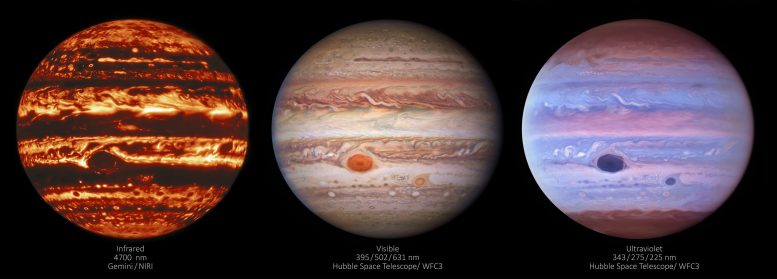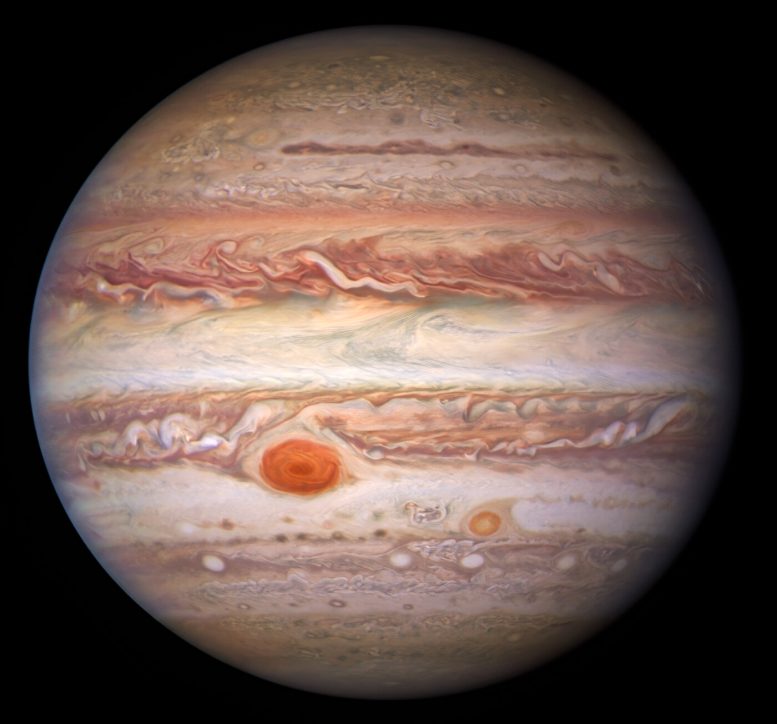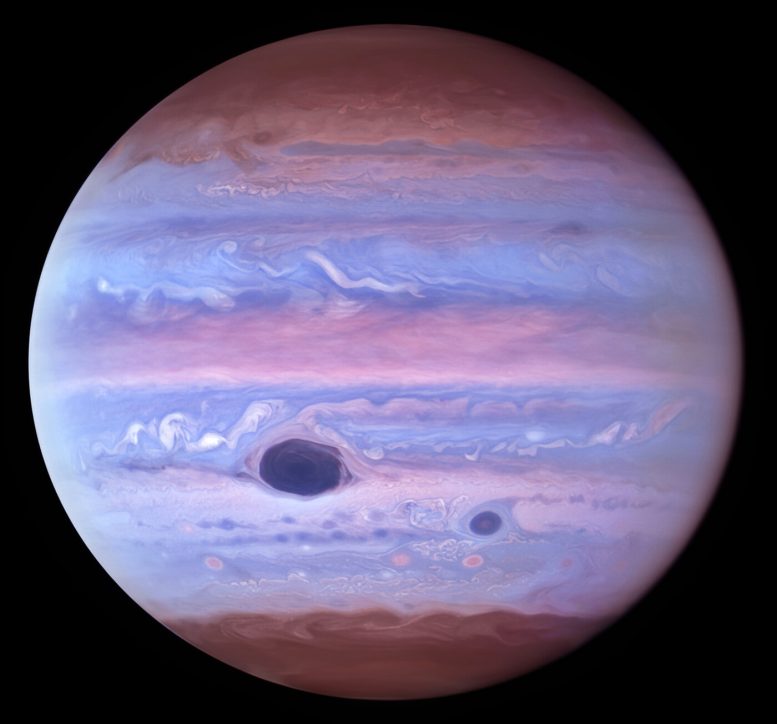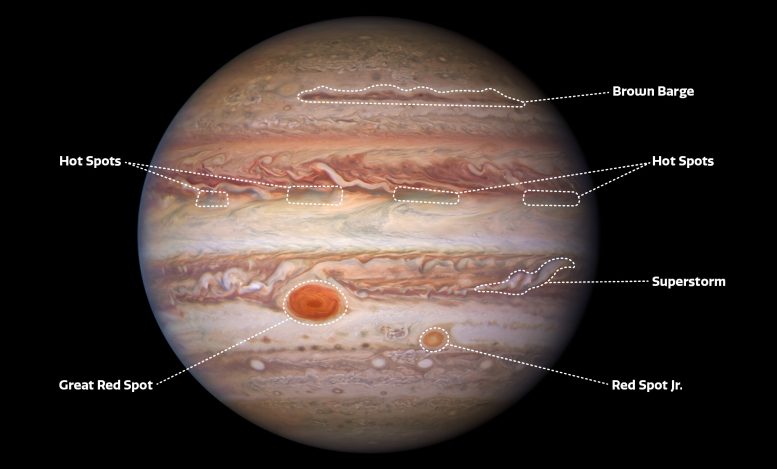By Jove! Stunning New Images Show Jupiter’s Great Red Spot, Superstorms, and Gargantuan Cyclones

Three images of Jupiter show the gas giant in three different types of light — infrared, visible, and ultraviolet. The image on the left was taken in infrared by the Near-InfraRed Imager (NIRI) instrument at Gemini North in Hawaiʻi, the northern member of the international Gemini Observatory, a Program of NSF’s NOIRLab. The center image was taken in visible light by the Wide Field Camera 3 on the Hubble Space Telescope. The image on the right was taken in ultraviolet light by Hubble’s Wide Field Camera 3. All of the observations were taken on 11 January 2017. Credit: International Gemini Observatory/NOIRLab/NSF/AURA/NASA/ESA, M.H. Wong and I. de Pater (UC Berkeley) et al.
Stunning new images of Jupiter from Gemini North and the NASA/ESA Hubble Space Telescope showcase the planet at infrared, visible, and ultraviolet wavelengths of light. These views reveal details in atmospheric features such as the Great Red Spot, superstorms, and gargantuan cyclones stretching across the planet’s disk. Three interactive images allow you to compare observations of Jupiter at these different wavelengths and explore the gas giant’s clouds yourself!
Three striking new images of Jupiter show the stately gas giant at three different types of light — infrared, visible, and ultraviolet. The visible and ultraviolet views were captured by the Wide Field Camera 3 on the Hubble Space Telescope, while the infrared image comes from the Near-InfraRed Imager (NIRI) instrument at Gemini North in Hawaiʻi, the northern member of the international Gemini Observatory, a Program of NSF’s NOIRLab. All of the observations were taken simultaneously (at 15:41 Universal Time) on January 11, 2017.
These three portraits highlight the key advantage of multiwavelength astronomy: viewing planets and other astronomical objects at different wavelengths of light allows scientists to glean otherwise unavailable insights. In the case of Jupiter, the planet has a vastly different appearance in the infrared, visible, and ultraviolet observations. The planet’s Great Red Spot — the famous persistent storm system large enough to swallow the Earth whole — is a prominent feature of the visible and ultraviolet images, but it is almost invisible at infrared wavelengths. Jupiter’s counter-rotating bands of clouds, on the contrary, are clearly visible in all three views.

This infrared view of Jupiter was created from data captured on 11 January 2017 with the Near-InfraRed Imager (NIRI) instrument at Gemini North in Hawaiʻi, the northern member of the international Gemini Observatory, a Program of NSF’s NOIRLab. It is actually a mosaic of individual frames that were combined to produce a global portrait of the planet. In the image warmer areas appear bright, including four large hot spots that appear in a row just north of the equator. South of the equator, the oval-shaped and cloud-covered Great Red Spot appears dark. Credit: International Gemini Observatory/NOIRLab/NSF/AURA, M.H. Wong (UC Berkeley) et al., Acknowledgments: M. Zamani
Observing the Great Red Spot at multiple wavelengths yields other surprises — the dark region in the infrared image is larger than the corresponding red oval in the visible image. This discrepancy arises because different structures are revealed by different wavelengths; the infrared observations show areas covered with thick clouds, while the visible and ultraviolet observations show the locations of chromophores — the particles that give the Great Red Spot its distinctive hue by absorbing blue and ultraviolet light.

This visible-light image of Jupiter was created from data captured on 11 January 2017 using the Wide Field Camera 3 on the Hubble Space Telescope. Near the top, a long brown feature called a ‘brown barge’ extends 72,000 kilometers (nearly 45,000 miles) in the east-west direction. The Great Red Spot stands out prominently in the lower left, while the smaller feature nicknamed Red Spot Jr. (known to Jovian scientists as Oval BA) appears to its lower right. Credit: NASA/ESA/NOIRLab/NSF/AURA/M.H. Wong and I. de Pater (UC Berkeley) et al.
Acknowledgments: M. Zamani
The Great Red Spot isn’t the only storm system visible in these images. The region sometimes nicknamed Red Spot Jr. (known to Jovian scientists as Oval BA) appears in both the visible and ultraviolet observations.[1] This storm — to the bottom right of its larger counterpart — formed from the merger of three similar-sized storms in 2000.[2] In the visible-wavelength image, it has a clearly defined red outer rim with a white center. In the infrared, however, Red Spot Jr. is invisible, lost in the larger band of cooler clouds, which appear dark in the infrared view. Like the Great Red Spot, Red Spot Jr. is colored by chromophores that absorb solar radiation at both ultraviolet and blue wavelengths, giving it a red color in visible observations and a dark appearance at ultraviolet wavelengths. Just above Red Spot Jr. in the visible observations, a Jovian superstorm appears as a diagonal white streak extending toward the right side of Jupiter’s disk.

This ultraviolet image of Jupiter was created from data captured on 11 January 2017 using the Wide Field Camera 3 on the Hubble Space Telescope. The Great Red Spot and Red Spot Jr. (also known as Oval BA) absorb ultraviolet radiation from the Sun and therefore appear dark in this view. Credit: NASA/ESA/NOIRLab/NSF/AURA/M.H. Wong and I. de Pater (UC Berkeley) et al., Acknowledgments: M. Zamani
One atmospheric phenomenon that does feature prominently at infrared wavelengths is a bright streak in the northern hemisphere of Jupiter. This feature — a cyclonic vortex or perhaps a series of vortices — extends 72,000 kilometers (nearly 45,000 miles) in the east-west direction. At visible wavelengths the cyclone appears dark brown, leading to these types of features being called ‘brown barges’ in images from NASA’s Voyager spacecraft. At ultraviolet wavelengths, however, the feature is barely visible underneath a layer of stratospheric haze, which becomes increasingly dark toward the north pole.
Similarly, lined up below the brown barge, four large ‘hot spots’ appear bright in the infrared image but dark in both the visible and ultraviolet views. Astronomers discovered such features when they observed Jupiter in infrared wavelengths for the first time in the 1960s.
As well as providing a beautiful scenic tour of Jupiter, these observations provide insights about the planet’s atmosphere, with each wavelength probing different layers of cloud and haze particles. A team of astronomers used the telescope data to analyze the cloud structure within areas of Jupiter where NASA’s Juno spacecraft detected radio signals coming from lightning activity.

Labels added to this visible-light Hubble Space Telescope image of Jupiter point out several atmospheric features on the planet, including a ‘brown barge’, four hot spots (which appear bright in the infrared image from Gemini North), a superstorm, the Great Red Spot, and Red Spot Jr. (also known as Oval BA). Credit: NASA/ESA/NOIRLab/NSF/AURA/M.H. Wong and I. de Pater (UC Berkeley) et al.
The scientific story behind these striking images is told in full in a new NOIRLab Stories blog post. As well as discovering the science behind these images, we invite you to inspect observations of Jupiter at home! Three interactive images let you compare observations of Jupiter at different wavelengths and peer beneath the gas giant’s clouds:
- Interactive image comparison of Gemini infrared data and Hubble visible data
- Interactive image comparison of Hubble visible data with Hubble ultraviolet data
- Interactive image comparison of Gemini infrared data with Hubble ultraviolet data
“The Gemini North observations were made possible by the telescope’s location within the Maunakea Science Reserve, adjacent to the summit of Maunakea,” acknowledges the observation team’s leader, Mike Wong of the University of California, Berkeley. “We are grateful for the privilege of observing Ka‘awela (Jupiter) from a place that is unique in both its astronomical quality and its cultural significance.”
More information on the infrared observations from Gemini is provided in the article Gemini Gets Lucky and Takes a Deep Dive Into Jupiter’s Clouds.
Notes
- While it appears red in Hubble’s visible-light image of Jupiter taken in January 2017, Red Spot Jr. does not always appear red. It was white when it first formed but turned red several years later. It has changed color since then and once again appears white.
- The three storms that merged to form Red Spot Jr. in 2000 were similar in size to each other and similar in size to Red Spot Jr. Interestingly, Red Spot Jr. did not become much larger than any of the three individual storms after they merged.
References
“High-resolution UV/Optical/IR Imaging of Jupiter in 2016–2019” by Michael H. Wong, Amy A. Simon, Joshua W. Tollefson, Imke de Pater, Megan N. Barnett, Andrew I. Hsu, Andrew W. Stephens, Glenn S. Orton, Scott W. Fleming, Charles Goullaud, William Januszewski, Anthony Roman, Gordon L. Bjoraker, Sushil K. Atreya, Alberto Adriani and Leigh N. Fletcher, 1 April 2020, The Astrophysical Journal Supplement Series.
DOI: 10.3847/1538-4365/ab775f
“First ALMA Millimeter-wavelength Maps of Jupiter, with a Multiwavelength Study of Convection” by Imke de Pater, R. J. Sault, Chris Moeckel, Arielle Moullet, Michael H. Wong, Charles Goullaud, David DeBoer, Bryan J. Butler, Gordon Bjoraker, Máté Ádámkovics, Richard Cosentino, Padraig T. Donnelly, Leigh N. Fletcher, Yasumasa Kasaba, Glenn S. Orton, John H. Rogers, James A. Sinclair and Eric Villard, 9 September 2019, The Astronomical Journal.
DOI: 10.3847/1538-3881/ab3643
More information
NSF’s NOIRLab (National Optical-Infrared Astronomy Research Laboratory), the US center for ground-based optical-infrared astronomy, operates the international Gemini Observatory (a facility of NSF, NRC–Canada, ANID–Chile, MCTIC–Brazil, MINCyT–Argentina, and KASI–Republic of Korea), Kitt Peak National Observatory (KPNO), Cerro Tololo Inter-American Observatory (CTIO), the Community Science and Data Center (CSDC), and Vera C. Rubin Observatory (in cooperation with DOE’s SLAC National Accelerator Laboratory). It is managed by the Association of Universities for Research in Astronomy (AURA) under a cooperative agreement with NSF and is headquartered in Tucson, Arizona. The astronomical community is honored to have the opportunity to conduct astronomical research on Iolkam Du’ag (Kitt Peak) in Arizona, on Maunakea in Hawaiʻi, and on Cerro Tololo and Cerro Pachón in Chile. We recognize and acknowledge the very significant cultural role and reverence that these sites have to the Tohono O’odham Nation, to the Native Hawaiian community, and to the local communities in Chile, respectively.
The Hubble Space Telescope is a project of international cooperation between NASA and the European Space Agency (ESA). NASA’s Goddard Space Flight Center in Greenbelt, Maryland, manages the telescope. The Space Telescope Science Institute (STScI) in Baltimore, Maryland, conducts Hubble science operations. STScI is operated for NASA by AURA.
.jpg?ext=.jpg)
.jpg?ext=.jpg)
 Swedish MEP Sara Skyttedal is one of the signatories to the letter (Image: Twitter)
Swedish MEP Sara Skyttedal is one of the signatories to the letter (Image: Twitter).jpg?ext=.jpg) (Image: NRIC)
(Image: NRIC)






